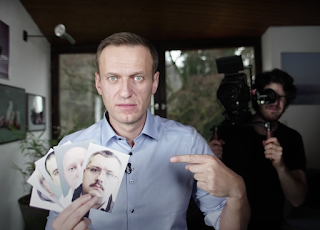 |
| Alexei Navalny with photos of his would-be assassins |
With the assistance of online investigation agency, Bellingcat, all four agents were completely identified and shown to have stalked Navalny for a number of years. With key contact details sourced by Bellingcat journalist Christo Grozev during this film, Navalny was able to phone each of them direct until one agent, under the impression that Navalny was from within the security service, divulged most of the details of the operation. It's a stunning and breathtaking set of statements captured during the filming.
Also interviewed in the film are Navaly's wife, Yulia (a key person in her own right) their adult children, his media adviser and his chief-of-staff. Navalny is shown to be a charismatic lawyer who does not shy away from difficult questions and enjoys strong support in Russia. This makes him the key target for Russian president Vladimir Putin who refuses to even mention his name when asked. On arrival back from Germany, Navalny was arrested and sent to a penal colony facing 20 years imprisonment.
Given Putin's autocratic rule in Russia and the war again the Ukraine, this documentary could not be more pertinent. It is a must-see film to better understand the severity of the forces that Putin deploys in Russia.






